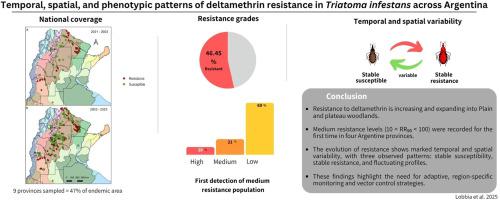阿根廷美洲锥虫对溴氰菊酯抗性的时空动态:恰加斯病媒控制的挑战。
IF 2.5
3区 医学
Q2 PARASITOLOGY
引用次数: 0
摘要
在广泛使用拟除虫菊酯的情况下,出现了对杀虫剂的抗药性,这是阿根廷有效控制恰加斯病媒的主要障碍。鉴于耐药性的蔓延及其对控制工作的影响,了解其地理和时间格局对于指导有弹性和有效的干预工作至关重要。本研究基于阿根廷9个省份2013-2023年期间溴氰菊酯抗性的时空分析,基于155个地点的感染弓状虫种群的生物毒理学分析,并结合文献中的历史抗性数据和杀虫剂使用分析。根据DL₅0值计算的电阻比,电阻水平被分为低、中或高。结果显示,溴氰菊酯抗性种群占46.45%,抗性种群分布在5个省份,呈明显的地理扩展趋势。我们报告了四个省首次广泛出现的中等抗性水平(10 < RR₅0 < 100),以及向新生态区的地理扩展,突出了具有显着区域差异的抗性进化的积极过程。将抗性数据与杀虫剂施用相结合,我们观察到病媒种群中有三种不同的抗性模式:稳定易感、稳定抗性和随时间变化的抗性水平。我们的研究结果表明,传统的拟除虫菊酯治疗可能是不够的,特别是在高耐药性地区。这项研究强调需要采取适应性的、针对特定区域的管理方法,并整合阿根廷国家农药耐药性监测网络(RAReP)发起的持续监测工作。这些努力对于提高病媒控制效果和减轻恰加斯病的传播至关重要。本文章由计算机程序翻译,如有差异,请以英文原文为准。

Spatio-temporal dynamics of deltamethrin resistance in Triatoma infestans: Challenges for chagas disease vector control in Argentina
The emergence of insecticide resistance in Triatoma infestans, driven by extensive pyrethroid use, represents a major obstacle to effective Chagas disease vector control in Argentina. Given the spread of resistance and the impact on control efforts, understanding its geographical and temporal patterns is crucial for guiding resilient and effective intervention efforts. This study presents a spatio-temporal analysis of deltamethrin resistance across nine Argentine provinces during 2013–2023 period, based on biotoxicological assays of T. infestans populations collected from 155 locations, complemented by historical resistance data from the literature and analysis of insecticide application. Resistance levels were classified as low, medium, or high based on resistance ratios calculated from DL₅₀ values. Results show that 46.45 % of the populations analyzed were resistant to deltamethrin, with resistant populations found in five provinces, indicating a notable geographic expansion into new ecoregions. We report the first widespread emergence of medium resistance levels (10 < RR₅₀ < 100) in four provinces, alongside geographic expansion into new ecoregions, highlighting an active process of resistance evolution with notable regional variability. Combining resistance data with insecticide application we observed three distinct resistance patterns in vector populations: stable susceptible, stable resistance, and variable resistance levels over time. Our findings suggest that conventional pyrethroid treatments may be insufficient, especially in high-resistance regions. This study underscores the need for adaptive, region-specific management approaches and the integration of continuous monitoring efforts, as initiated by Argentina’s National Pesticide Resistance Surveillance Network (RAReP). These efforts are essential for enhancing vector control efficacy and mitigating the spread of Chagas disease.
求助全文
通过发布文献求助,成功后即可免费获取论文全文。
去求助
来源期刊

Acta tropica
医学-寄生虫学
CiteScore
5.40
自引率
11.10%
发文量
383
审稿时长
37 days
期刊介绍:
Acta Tropica, is an international journal on infectious diseases that covers public health sciences and biomedical research with particular emphasis on topics relevant to human and animal health in the tropics and the subtropics.
 求助内容:
求助内容: 应助结果提醒方式:
应助结果提醒方式:


